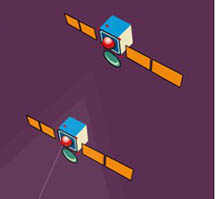Amos 1 and Amos 2 will be close to each other in space to allow the use of one antenna for both
By: Avi Weiss
 Ahead of the launch of the "Amos 2" satellite produced by the Space Company on December 25, using the Russian "Soyuz" satellite from Kazakhstan, the question is sharpening whether this satellite and similar ones will have other uses, besides transmitting television broadcasts to subscribers around the world. The research company Northern Sky Research, which specializes in research in the field of aviation and space, tried to answer this question.
Ahead of the launch of the "Amos 2" satellite produced by the Space Company on December 25, using the Russian "Soyuz" satellite from Kazakhstan, the question is sharpening whether this satellite and similar ones will have other uses, besides transmitting television broadcasts to subscribers around the world. The research company Northern Sky Research, which specializes in research in the field of aviation and space, tried to answer this question.
According to the study, the ITU divided the sky so that 307 geosynchronous satellites (fixed in space above a certain point above the Earth - GEO) can be operated, and this in addition to 497 non-geosynchronous satellites. Such an amount of 807 satellites in space around the Earth was supposed to provide services above and beyond their traditional applications, applications that were actually developed back in the 80s.
One of the directions developed in the 90s is the use of Ka-Band, which contains 2.5 to 3.5 GHz of wireless spectrum for data uses, primarily broadband internet connections, as well as various information uses for business and digital telephony. Ka-Band uses the frequency band 27.5-30 GHz in the uplink channel to the satellite, and 17.7-21.2 GHz in the downlink channel.
In 1997, 59 different Ka-Band projects were announced around the world, but to this day nothing real has happened and the issue has not caught on. With the increase in the consumption of Internet bandwidths, a satellite solution seemed to be the most suitable for the public. In total, it was planned that from 1999 to 2006, at least 1,335 satellites will be launched around the earth, which will enable a very wide range of Internet services from space. In fact, as of the end of 2003, only 17 satellites provide Ka-Band services, out of the hundreds of satellites in space. The leading company in this field in the world is Spaceway, which also uses the Ku-Band frequency range.
One of the reasons for the fall is the fact that the prices of information traffic in optical fibers fell sharply, and they became more attractive than the prices of satellite traffic.
The success of DSL and cable modems, which are actually based on fiber optic traffic, left no room for the success of KA-Band. After 8 years of operation of KA-Band services, they have barely 500 thousand customers in the United States (compared to tens of millions of customers of wired broadband connections). Some success was recorded in Australia, but that was all. Companies like EchoStar and WildBlue, as well as Israel's Gilat, reached the brink of bankruptcy.
According to the researchers, without Killer Application there is no future for Ka-Band, including plans to provide Ka-Band services on the Ku-Band frequency band, which is designed to lower costs and increase data rates. Although the FCC has in the past two years given Ka-Band licenses to a large number of companies, such as Boeing, ICO, Iridium, Globalstar and TMI, with a requirement to start sending satellites starting in 2004 and complete deployment by mid-2007, but today this plan seems hopeless economic.
Regarding satellite broadband connections in Israel using "Amos 2", it is indeed too early to predict, but there is no doubt that our satellite will probably not occupy a central place in Israel in terms of broadband Internet connections.
* Avi Weiss is an independent communications consultant and senior commentator in the "People and Computers" group, which includes the weekly InformationWeek-Israel, and the online newsletters (in Hebrew) Daily Maily and Telecom
